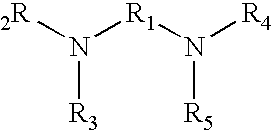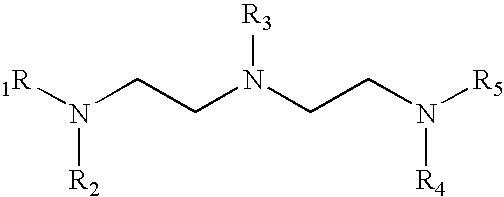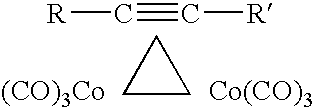Catalyst system for rendering organic propellants hypergolic with hydrogen peroxide
a technology of hydrogen peroxide and propellants, which is applied in the direction of looms, explosives, textiles and papermaking, etc., can solve the problems of inability to prepare in non-polar organic fuels, insoluble particles with undesirable properties of coagulation or precipitation, and ineffectiveness, etc., to achieve the effect of improving stability
- Summary
- Abstract
- Description
- Claims
- Application Information
AI Technical Summary
Benefits of technology
Problems solved by technology
Method used
Image
Examples
example 1
Manganese (II) Acetate Tetrahydrate and TMEDA
[0029]2.45 grams of manganese (II) acetate tetrahydrate (“MAT”) dissolves in 24.5 grams of N,N,N′,N′-Tetramethylethylenediamine (“TMEDA”) at 20° C. to form a non-turbid, pale yellow or straw colored solution (9.1% MAT by weight). Chilling of this solution to 0° C. overnight did not result in any precipitate falling out of solution.
[0030]If the excess TMEDA is removed by gentle heating in vacuo, an off-white or pale ivory crystalline solid remains, easily distinguished from the characteristic pale pink hue of manganese (II) acetate tetrahydrate. Analysis of this complex revealed that it contains no water of hydration and consists of one molecule of manganese (II) acetate bound to one molecule of TMEDA. It decomposes upon heating to 120° C., with the accompanying loss of TMEDA. The compound is very sparingly soluble in aliphatic hydrocarbons (<1% by wt. in kerosene), but freely soluble in alcohols and acetylenic hydrocarbons.
[0031]Solutions...
example 2
Crystalline Manganese Acetate-TMEDA Complex
[0037]0.1 grams of the crystalline manganese acetate-TMEDA complex (containing no free TMEDA) was dissolved in a mixture of 2.50 grams of 1,4-dicyclopropylbuta-1,3-diyne (the dimer of ethynlcyclopropane or “ECP dimer”). No free TMEDA was added. The resulting solution was intensely hypergolic.
[0038]0.1 grams of the crystalline manganese acetate-TMEDA complex (containing no free TMEDA) was dissolved in a mixture of 0.75 grams of 1,4-dicyclopropylbuta-1,3-diyne (the dimer of ethynlcyclopropane or “ECP dimer”) and 0.75 grams of kerosene. No free TMEDA was added. The resulting solution was extremely hypergolic.
example 3
Cobalt (II) Acetate Tetrahydrate and TMEDA
[0039]0.2 grams of cobalt (II) acetate tetrahydrate was dissolved in 3.0 grams TMEDA, forming a transparent magenta solution. If the excess TMEDA is removed by gentle heating in vacuo, a magenta crystalline solid remains, easily distinguished from the characteristic intense magenta hue of cobalt (II) acetate tetrahydrate. Analysis of this complex reveals that it contains no water of hydration and consists of one molecule of cobalt (II) acetate bound to one molecule of TMEDA. This compound melts at 154° C. without the accompanying loss of TMEDA. It is very sparingly soluble in aliphatic hydrocarbons and kerosene (<1% by wt.), but freely soluble in alcohols and acetylenic hydrocarbons that are ideal rocket propellants.
[0040]A solution of cobalt (II) acetate in TMEDA is appreciably more stable to autoxidation than its manganese analog. However, upon exposure to air (or sparging of air using a fritted air stone), solutions of the cobalt (II) ace...
PUM
| Property | Measurement | Unit |
|---|---|---|
| weight % | aaaaa | aaaaa |
| polar | aaaaa | aaaaa |
| non-polar | aaaaa | aaaaa |
Abstract
Description
Claims
Application Information
 Login to View More
Login to View More - R&D
- Intellectual Property
- Life Sciences
- Materials
- Tech Scout
- Unparalleled Data Quality
- Higher Quality Content
- 60% Fewer Hallucinations
Browse by: Latest US Patents, China's latest patents, Technical Efficacy Thesaurus, Application Domain, Technology Topic, Popular Technical Reports.
© 2025 PatSnap. All rights reserved.Legal|Privacy policy|Modern Slavery Act Transparency Statement|Sitemap|About US| Contact US: help@patsnap.com



